Quick answer: What is the most visited National Park in Madagascar? It’s Isalo National Park — a sweeping, sunburnt landscape of sandstone massifs, deep canyons, and cool natural pools that draw thousands of visitors each year.
Your Ultimate Guide begins here. Expect a clear Table of Clarity next with travel times, best seasons, required guides, and where Isalo sits on the RN7 route from Antananarivo.
Isalo spans over 80,000 hectares since 1962 and offers iconic sunsets, easy-to-moderate trails, and striking rock windows. This park is a superb base for mixed experiences — canyon hikes, wildlife sightings, and cultural stops along the coast and inland routes.
Plan realistically: Madagascar is a large island with limited infrastructure. Flights can delay and highways are long, so focus on fewer regions for deeper discovery.
Key Takeaways
- Isalo National Park is the top draw for canyon views and natural pools.
- Expect a Table of Clarity with access, seasons, and guide rules next.
- Logistics matter: fly into Antananarivo and consider RN7 overland options.
- Compare parks: Andasibe for indri calls; Kirindy for fossa; Tsingy for limestone treks.
- Bring sun protection, plenty of water, and time for road travel.
Quick Answer and Table of Clarity
Get the short answer and a scannable facts grid to plan your Isalo visit.
Direct Answer Upfront
Direct answer: Isalo National Park tops the list as Madagascar’s most popular natural destination—celebrated for dramatic canyons, sandstone rock formations, and inviting natural pools that reward active days on the island.
Table of Clarity: Key Facts at a Glance
| Feature | Quick facts | Notes |
|---|---|---|
| Area | ~80,000 hectares | Jurassic sandstone massifs and deep canyons |
| Climate & peak months | Dry year-round; Jul–Aug & Dec busiest | Temperatures often exceed 30°C |
| Access | RN7 road or flight to Toliara + 3-hr drive | About 15 hours by road from the capital |
| Hours & entry | Ranohira office opens after 6:30 | Hire a local guide at arrival; guides required |
| Top highlights | Window of Isalo, Canyon de Namaza, Piscine Noire & Bleue | 4×4 transfers shorten some approaches |
Why Isalo Tops Visitor Numbers Today
Isalo’s appeal is simple and powerful: varied scenery in one protected area means dramatic photos, short hikes, and rewarding swims on the same trip day. The park sits along a classic overland route, making it an easy, high-value stop for island itineraries.
Practical tip: Start hikes early to avoid midday heat, carry extra water, and use your guide to find quieter valleys where wildlife and unique species gather near pockets of forest.
Geographic & Contextual Overview of Madagascar’s National Parks
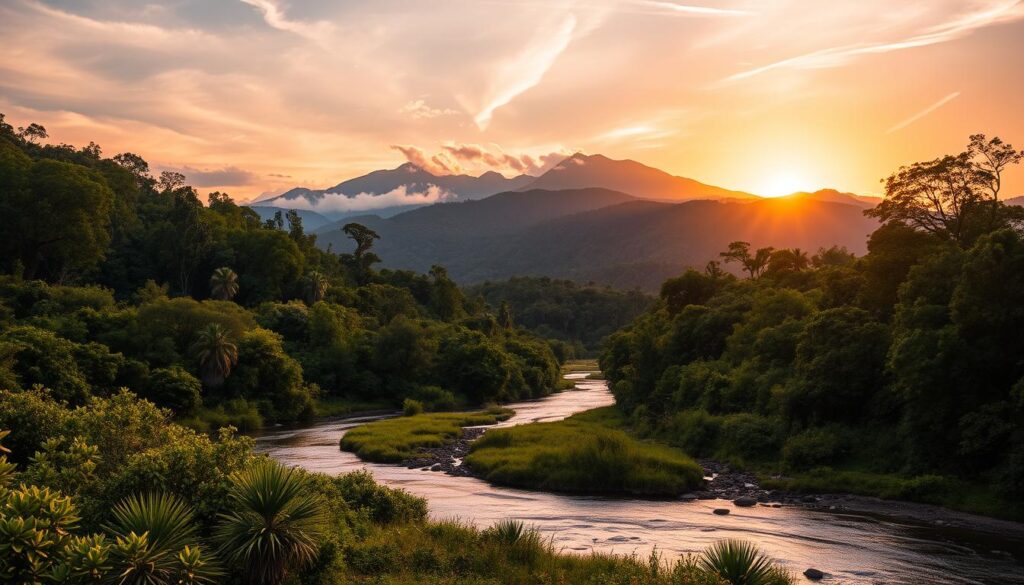
Plan travel time wisely: Madagascar’s transport shapes your itinerary. Start in the capital and allow buffer days for regional flights or slow road transfers.
The RN7 is the island’s classic overland spine. It links Antananarivo south through Antsirabe, past Ranomafana, and on toward Ranohira—your gateway town for Isalo. From Toliara, expect about three hours by road to reach canyon country.
Practical routing and timing
- Buffer your schedule: internal flights can change; add extra days before key departures.
- Choose depth over breadth: long drives mean a smart tour focuses on two to three regions per trip.
- Combine coast and canyons: fly to Maroansetra for Masoala then boat, or link Toliara with southwest beaches.
| Route | Typical time | Notes |
|---|---|---|
| Antananarivo → Ranomafana (RN7) | 8–10 hours by road | Scenic highlands; useful town stops at Antsirabe |
| Toliara → Isalo | ~3 hours drive | Fly to Toliara to cut road time |
| Maroansetra → Masoala | Flight + 1.5 hr boat | Remote coast access; plan logistics carefully |
| Miandrivazo → Tsiribihina river | Multi-day river cruise | Relaxed pace; culture and scenery along river banks |
Tip: Match your desired species and landscapes to travel time. Each national park offers distinct habitats across the island—so plan days to see both wildlife and scenery without rushing.
About Isalo National Park: Madagascar’s Most Visited Natural Park
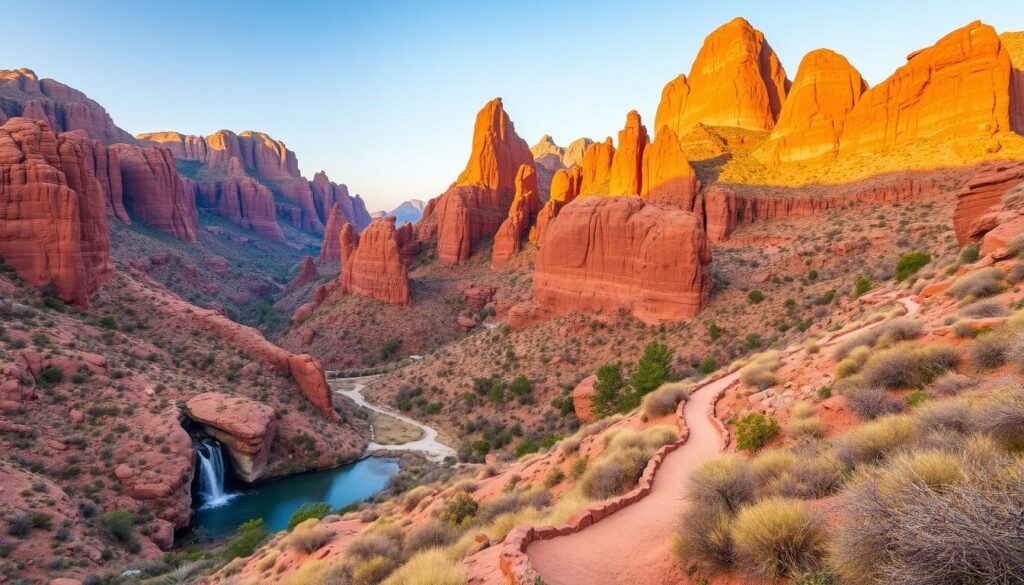
Step into a landscape of sculpted sandstone and hidden pools that reward every hiker. This isalo national park covers vast Jurassic-era plateaus, dramatic canyons, and palm-lined oases across more than 80,000 hectares.
Signature Landscapes
The site offers towering sandstone walls, sculpted rock formations, and narrow gorges that open onto bright natural pools. Expect sudden shady valleys flanked by Tapia trees and resilient aloes.
Top Things to Do
Plan for highlights:
- Window of Isalo at sunset for golden light and wide views.
- Hike Canyon de Namaza to reach Piscine Bleue and Piscine Noire for cooling swims.
- Choose short loops or multi-day traverses—guides tailor routes to your fitness and daylight.
Wildlife Highlights
Ring-tailed lemurs and other lemur species are common along trails. You may come across Benson rock-thrush, reptiles, and spoor of the fossa. This wildlife mix gives the park strong photographic appeal.
When to Go, How to Get There & Where to Stay
The climate is dry year-round; July–August and December are busiest—book early. Drive RN7 from Antananarivo (roughly 15 hours with stops) or fly to Toliara and transfer about three hours to Ranohira. Ranohira office opens after 6:30 and guides are required.
Where you’ll sleep: options range from budget town hotels to luxury lodges and two basic campsites inside the park. Carry plenty of water, sun protection, and a hat to stay safe on hot days.
Practical Travel Info, Costs & Trip Planning for Visitors
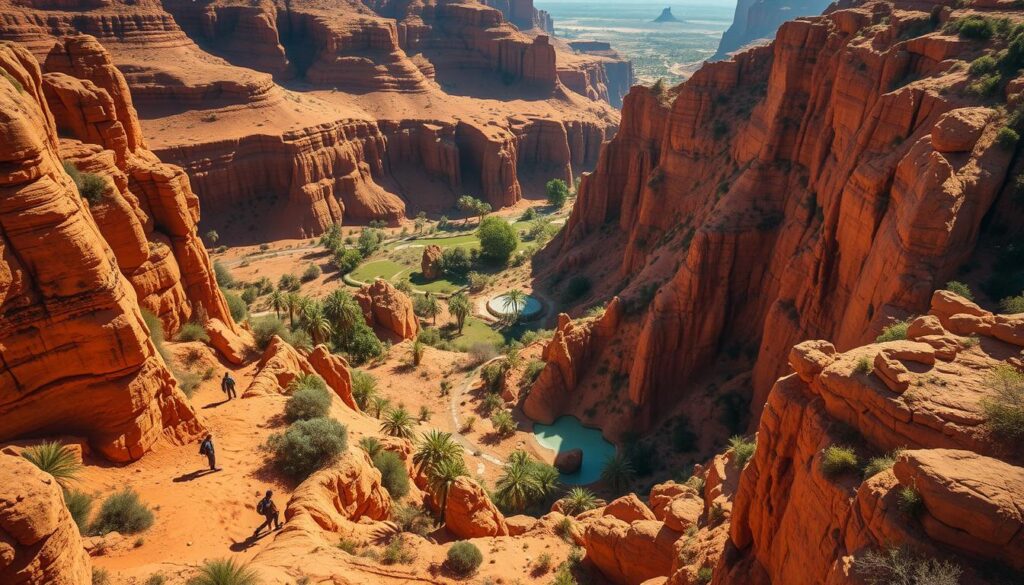
Plan your visit with clear logistics: entry, fees, and realistic pacing for canyon days. Start at the Ranohira park office in town after 6:30 to pay entry fees, pick routes, and hire your required guide for the day.
Typical pacing: many travelers spend 2–3 days here—one day for canyons and pools, one for plateau views and sunset, and a flex day for a longer loop. Plan early departures, a mid-day rest, and late-afternoon viewpoints to beat heat and maximize shade.
Costs and transport: budget for RN7 overland transfers or a flight to Toliara plus a 3-hour drive. Guides set rates by trail; 4x4s are available for quicker roadheads. Accommodation ranges from budget town hotels to luxury lodges and two basic campsites inside the park.
- Carry ample water on trail—dry air and exposed rock speed dehydration.
- Most guides speak French; ask for English or naturalist-focused guides for species interpretation.
- Combine this trip with Ranomafana (9–10 hours from Ranohira) or Antsirabe as you map island time.
Comparisons with Other National Parks in Madagascar and Beyond
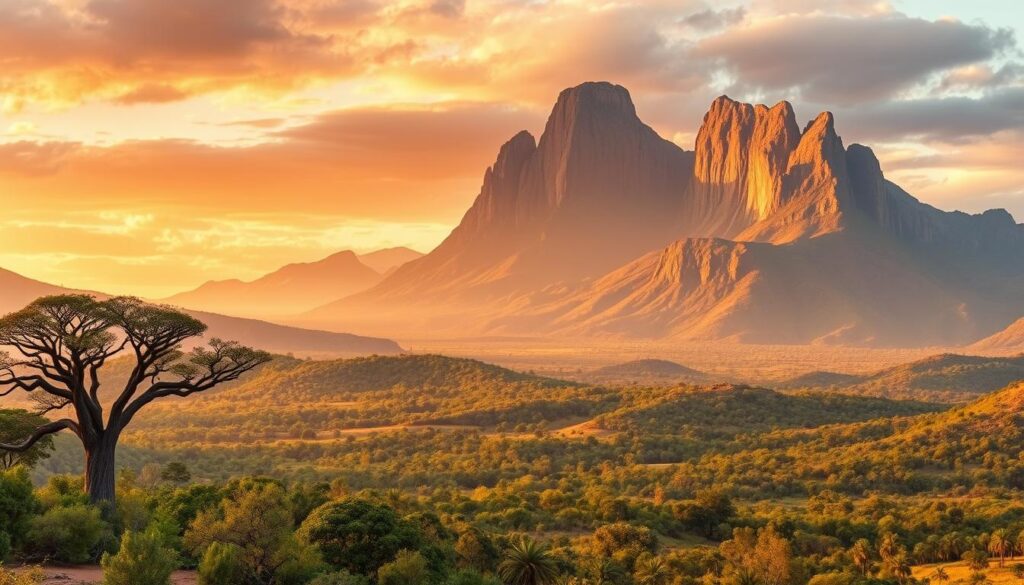
Across Madagascar, parks love to surprise — from cathedral-like karsts to coastal rainforest and sculpted canyon country. Match your interests to habitats and timing to get the best wildlife and scenery.
Best places for lemurs and predators:
- Ranomafana National Park: humid forest trails where multiple lemur species appear on regular walks.
- Andasibe: your top place for indri calls at dawn and close encounters.
- Kirindy: fossa viewing and night walks—rare predators and nocturnal lemurs come across after dark.
Scenery, tourism and global standing
Tsingy de Bemaraha wows with limestone formations and airy trails. Masoala National Park combines rainforest and coast—kayak bays, hike trails, and whale season from July to early September.
Travel note: parks madagascar offer world-class wildlife but limited infrastructure. Guided safaris and local naturalist guides raise your chance to see species and enrich every trip.
| Park type | Highlight | Best for |
|---|---|---|
| Isalo | canyons, pools | sunset views & easy hikes |
| Ranomafana | wet forest | lemurs & research trails |
| Masoala | rainforest + coast | marine life & remote forests |
Conclusion
Close your itinerary with a clear choice: isalo national park rewards hikers with golden canyon light, clear natural pools, and approachable routes.
Plan smart: give yourself extra time for overland days on the island and let a local guide shape your tour. Carry plenty of water, start early, and take shade breaks to beat heat.
Mix habitats—forest walks, coastal stops, and canyon vistas—to see more wildlife and endemic species across parks. Slow travel across days creates a better chance for sightings among trees and along shorelines.
Go with purpose: support conservation-minded lodges and guides. The world’s rich nature waits—choose experiences that leave places stronger and your trip unforgettable.
FAQ
Which park draws the most visitors in Madagascar?
Isalo National Park attracts the highest annual visitor numbers, thanks to its dramatic sandstone massifs, deep canyons, and popular natural pools near Ranohira.
Why is Isalo so popular with travelers?
Isalo combines easy access from Antananarivo via RN7, iconic rock formations, reliable dry-season weather, and diverse activities—hiking, swimming in Piscine Naturelle, dramatic sunsets at the Window of Isalo, and close lemur encounters.
How do visitors typically reach Isalo from the capital?
Most travelers drive RN7 south from Antananarivo—a scenic road trip with stops in Antsirabe and Ambositra—or fly to Toliara and take a transfer to Ranohira for the park entrance.
What are Isalo’s must-see landscapes and highlights?
Look for sandstone canyons, natural pools such as Piscine Noire and Piscine Bleue, the Window of Isalo at sunset, and sculpted rock formations carved by wind and water over millennia.
Which lemur species and animals can I expect to see?
Ring-tailed lemurs are common on trails, and Decken’s sifaka can appear nearby. Birdwatchers will spot endemic species, and cautious visitors may learn of fossa sightings in surrounding dry forests.
When is the best time to visit Isalo for hiking and swimming?
The dry season (April to November) offers clear trails and comfortable temperatures. Peak months bring more visitors, while shoulder months still allow good access and fewer crowds.
What are typical park hours, guide rules, and entry fees?
Park hours vary by season, but gates usually open at sunrise and close before dusk. Local guides are required for many trails—hire certified guides at the park office. Entry fees and guide rates change, so check current rates before travel.
How long should I plan to explore Isalo?
Plan 1–3 days to see core attractions: a half-day canyon hike, a sunrise or sunset viewpoint, and a day for longer loops that include natural pools and varied landscapes.
What budget should I expect for transportation, lodging, and guides?
Costs depend on style: budget travelers can stay in basic guesthouses and share guides, while mid-range to luxury lodges and private guided treks raise the price. Include RN7 transport or flights to Toliara, park fees, and guide tips in your estimate.
Can Isalo be combined with other parks on a Madagascar itinerary?
Yes—common combos include Isalo with Ranomafana for rainforest and lemur diversity, or continuing RN7 north to Antsirabe and Andasibe for indri viewing. Coastal extensions to the northwest or Masoala require flights and more time.
How does Isalo compare to Ranomafana, Masoala, and Tsingy de Bemaraha?
Isalo excels for spectacular sandstone scenery, canyons, and dry-country wildlife. Ranomafana offers lush rainforests and high lemur diversity, Masoala provides remote coastal rainforest and marine life, and Tsingy showcases dramatic limestone karsts—each park delivers different highlights.
Where should I go for the best chance to see indri or a fossa?
For indri, head to Andasibe-Mantadia and Analamazaotra. For fossa sightings, Kirindy Forest on the west coast has higher chances, though fossa remain elusive and sightings are never guaranteed.
Is Madagascar ready for tourism—are services and guides reliable?
Madagascar offers outstanding biodiversity and unique experiences, but infrastructure varies. Hire local licensed guides, book transfers through reputable operators, and allow extra time for road travel on RN7 and regional routes.
What should I pack and prepare for an Isalo trip?
Bring sturdy hiking shoes, sun protection, refillable water, layered clothing for cool mornings and hot afternoons, swimwear for natural pools, insect repellent, and a good daypack for guided hikes.
Are there safe places to stay near Isalo for different budgets?
Ranohira village offers budget guesthouses and mid-range lodges, while luxury eco-lodges sit on park edges for comfort and views. Camping is possible with guides and permits for a closer-to-nature experience.
How can I support conservation and local communities when visiting?
Choose local guides and community-run tours, stay in lodges that invest in conservation, follow park rules, avoid disturbing wildlife, and respect cultural sites to leave a positive impact.
- Kaas Plateau Travel Guide 2026: Best Time to Visit, Bloom Season, How to Reach & FAQs
- What Is the Quirimbas Archipelago Mozambique Known For? Complete Travel & Nature Guide
- Is Angola Safe to Travel in 2025? Your Essential Guide to Health, Crime, and Landmine Safety
- What Animals Live in Bale Mountains Ethiopia? Complete Wildlife Guide
- What to Do in Damaraland — Complete Travel Guide for First-Timers

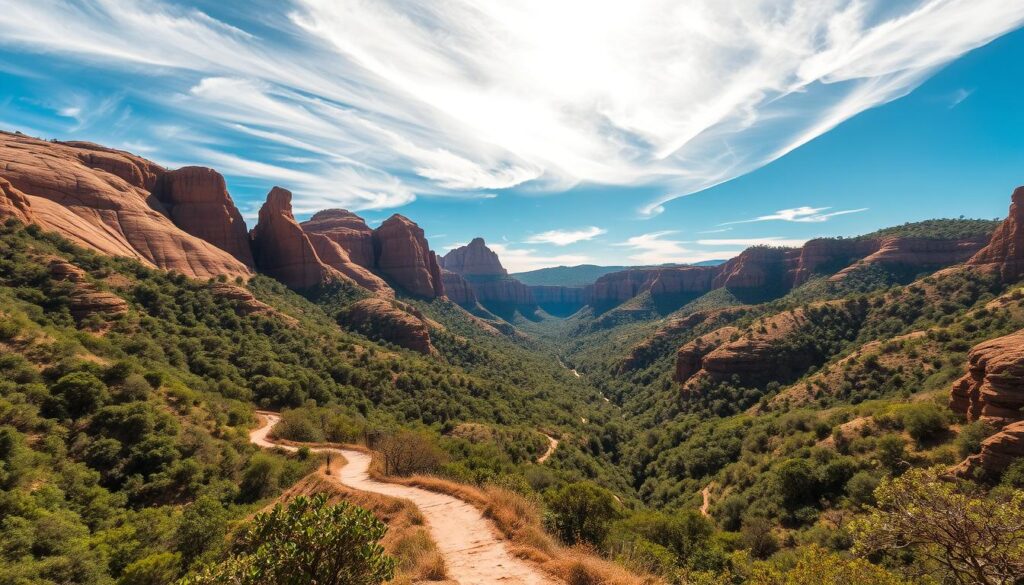
This website is really a stroll-by means of for all the info you wished about this and didn’t know who to ask. Glimpse right here, and you’ll definitely discover it.